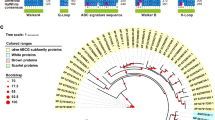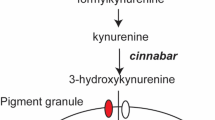Abstract
The Oriental fruit fly Bactrocera dorsalis (Hendel) is a highly significant, invasive pest of fruits which severely affect the global fruit trade. The advent of CRISPR/Cas9 has opened up new avenues for developing futurist management approaches as standalone or complementing other approaches. In this context, numerous earlier studies have documented the mutation of the white locus in B. dorsalis. Studies on Drosophila melanogaster and D. suzukii demonstrated that the white locus (wh) plays a crucial role in pigmentation and various other physiological functions like reproduction. Therefore, in the present study, we have generated a homozygous white eye mutants (wh−/−) bearing a four base pair deletion and studied the possible effects on the biological attributes such as reproductive fitness and body size as compared to the wild flies. A single pair of adults produced significantly lesser offsprings (5.80 ± 3.67 pupae) in the cross involving wh−/−♀ × wh−/−♂ than in the WT♀ × WT♂ cross (21.80 ± 3.91 pupae). The morphometric analysis showed that wh−/− individuals exhibited a reduced overall body size compared to wild-type males and females. Also, there was an overall increase in the life cycle of wh−/− individuals (23.20 ± 0.47 days) as compared to WT individuals (19.20 ± 0.51 days). This study provides comprehensive insights into the effects of the white gene mutation and provide potential avenues for future research on devising novel management strategies against B. dorsalis.







Similar content being viewed by others
Data Availability
The data that support the findings of this study are available from the corresponding author upon reasonable request.
References
Ames GFL (1986) Bacterial periplasmic transport systems: structure, mechanism, and evolution. Annu Rev Biochem 55:397–425
Anaka M, MacDonald CD, Barkova E, Simon K, Rostom R, Godoy RA, Haigh AJ, Meinertzhagen IA, Lloyd V (2008) The white gene of Drosophila melanogaster encodes a protein with a role in courtship behavior. J Neurogenet 22:243–276
Ashok K, Bhargava CN, Asokan R, Pradeep C, Kennedy JS, Rai A, Manamohan M (2023) First report on the utility of pupal case for early determination of CRISPR/Cas9 ribonucleoprotein mediated genomic edits in the oriental fruit fly, Bactrocera dorsalis (Hendel) (Tephritidae: Diptera). Arch Insect Biochem Physiol 113:e22024
Bai X, Zeng T, Ni XY, Su HA, Huang J, Ye GY, Lu YY, Qi YX (2019) CRISPR/Cas9-mediated knockout of the eye pigmentation gene white leads to alterations in colour of head spots in the oriental fruit fly, Bactrocera dorsalis. Insect Mol Biol 28:837–849
Borycz J, Borycz JA, Kubó WA, Lloyd V, Meinertzhagen IA (2008) Drosophila ABC transporter mutants white, brown and scarlet have altered contents and distribution of biogenic amines in the brain. J Exp Biol 211:3454–3466
Choo A, Crisp P, Saint R, O’Keefe LV, Baxter SW (2018) CRISPR/Cas9-mediated mutagenesis of the white gene in the tephritid pest Bactrocera tryoni. J Appl Entomol 142:52–58
Christenson LD, Foote RH (1960) Biology of fruit flies. Ann Rev Entomol 5:171–192
Dermauw W, Van Leeuwen T (2014) The ABC gene family in arthropods: comparative genomics and role in insecticide transport and resistance. Insect Biochem Mol Biol 45:89–110
Diamantidis AD, Carey JR, Papadopoulos NT (2008) Life-history evolution of an invasive tephritid. J Appl Entomol 132:695–705
Ewart GD, Howells AJ (1998) ABC transporters involved in transport of eye pigment precursors in Drosophila melanogaster. Meth Enzymol 292:213–224
Goodwill KE, Sabatier C, Stevens RC (1998) Crystal structure of tyrosine hydroxylase with bound cofactor analogue and iron at 2.3 A◦ resolution: self-hydroxylation of Phe300 and the pterin-binding site. Biochem 37:13437–13445
Kandul NP, Liu J, Sanchez HM, Wu SL, Marshall JM, Akbari OS (2019) Transforming insect population control with precision guided sterile males with demonstration in flies. Nat Commun 10:84
Mayr E (1946) Experiments on sexual isolation in Drosophila: VII. the nature of the isolating mechanisms between Drosophila pseudoobscura and Drosophila persimilis. PNAS 32:128–137
Miller DD (1958) Sexual isolation and variation in mating behavior within Drosophila athabasca. Evol 12:72–81
Morgan TH (1910) Sex limited inheritance in Drosophila. Science 32:120–122
Nolte DJ (1952) The eye-pigmentary system of Drosophila: III. The action of eye-colour genes. J Genet 51:142–186
Patty RA (1975) Investigation of genetic factors influencing duration of copulation in ‘eastern’ and ‘western’ Drosophila athabasca. Anim Behav 23:344–348
Spiess EB, Langer B (1964) Mating speed control by gene arrangements in Drosophila pseudoobscura homokaryotypes. PNAS 51:1015–1019
Spiess EB, Langer B, Li CC (1961) Chromosomal adaptive polymorphism in Drosophila persimilis III Mating propensity of homokaryotypes. Evolution 15:535–544
Sullivan DT, Sullivan MC (1975) Transport defects as the physiological basis for eye color mutants of Drosophila melanogaster. Biochem Genet 13:603–613
Tatematsu KI, Yamamoto K, Uchino K, Narukawa J, Iizuka T, Banno Y, Katsuma S, Shimada T, Tamura T, Sezutsu H, Daimon T (2011) Positional cloning of silkworm white egg 2 (w-2) locus shows functional conservation and diversification of ABC transporters for pigmentation in insects. Genes Cells 16:331–342
Virgilio M, Jordaens K, Verwimp C, White IM, De Meyer M (2015) Higher phylogeny of frugivorous flies (Diptera, Tephritidae, Dacini): localised partition conflicts and a novel generic classification. Mol Phylogenet Evol 85:171–179
Walker JE, Saraste M, Runswick MJ, Gay NJ (1982) Distantly related sequences in the alpha-and beta-subunits of ATP synthase, myosin, kinases and other ATP-requiring enzymes and a common nucleotide. EMBO J 1:945–951
White IM, Elson-Harris MM (1992) Fruit flies of economic significance: their identification and bionomics. CAB International
Wishard R, Karuppannasamy A, Asokan R, Nagaraja BC, Chalapathi P, Dhawane Y, Maligeppagol M, Rai A (2023) CRISPR/Cas9 editing of transformer2 gene of the Oriental fruit Fly, Bactrocera dorsalis (Hendel) (Diptera: Tephritidae) leads to intersex phenotype. J Asia Pac Entomol 26(2):102105
Xiao C, Qiu S, Robertson RM (2017) The white gene controls copulation success in Drosophila melanogaster. Sci Rep 7:7712
Xiao C, Robertson RM (2016) Timing of locomotor recovery from anoxia modulated by the white gene in Drosophila. Genet 203:787–797
Xiao C, Robertson RM (2017) White-cGMP interaction promotes fast locomotor recovery from anoxia in adult Drosophila. PLoS ONE 12:e0168361
Yan Y, Ziemek J, Schetelig MF (2020) CRISPR/Cas9 mediated disruption of the white gene leads to pigmentation eficiency and copulation failure in Drosophila suzukii. J Insect Physiol 126:104091
Zhang SD, Odenwald WF (1995) Misexpression of the white (w) gene triggers male-male courtship in Drosophila. PNAS 92:5525–5529
Zhao S, Xing Z, Liu Z, Liu Y, Liu X, Chen Z, Li J, Yan R (2019) Efficient somatic and germline genome engineering of Bactrocera dorsalis by the CRISPR/Cas9 system. Pest Manag Sci 75:1921–1932
Acknowledgements
The authors express their sincere gratitude to the Director, ICAR-IIHR for support and facilities. The current research work has been carried out of the funding received from the ICAR-CABin project and is highly acknowledged. First author and second author acknowledge the ICAR-JRF/SRF and DST-INSPIRE fellowships, respectively for their doctoral studies. The corresponding author is thankful to Dr. Max J. Scott and Dr. AmarishYadav, Department of Entomology & Plant Pathology, North Carolina State University, Raleigh, USA, for training on genome editing. All the authors greatly acknowledge Dr. P. Mahendiran, Senior Scientist, ICAR‐NBAIR, for imaging the flies.
Author information
Authors and Affiliations
Contributions
Chikmagalur Nagaraja Bhargava: Writing-original draft; formal analysis; investigation; validation; software; data curation. Karuppannasamy Ashok: Investigation; validation; formal analysis. Ramasamy Asokan: Conceptualization; methodology; project administration; writing-review and editing; funding acquisition; visualization. Karakatti Prasad Babu: methodology; Madhusoodanan Sujatha Parvathy: investigation; validation. Dhawane Yogi: investigation; validation; Thalooru Shashikala: investigation; validation; Rampura Kidinethra Chiranth: investigation; Ulligundam Ashok: investigation; Chowdenalli Gangadharaiah Harsha: investigation. All authors contributed to the article and approved the submitted version.
Corresponding author
Ethics declarations
Conflict of interest
The authors declare that they have no known competing financial interests or personal relationships that could have appeared to influence the work reported in this paper.
Ethical Approval
The authors declare that they have complied with ethical standards.
Additional information
Publisher's Note
Springer Nature remains neutral with regard to jurisdictional claims in published maps and institutional affiliations.
Supplementary Information
Below is the link to the electronic supplementary material.
Rights and permissions
Springer Nature or its licensor (e.g. a society or other partner) holds exclusive rights to this article under a publishing agreement with the author(s) or other rightsholder(s); author self-archiving of the accepted manuscript version of this article is solely governed by the terms of such publishing agreement and applicable law.
About this article
Cite this article
Bhargava, C.N., Ashok, K., Asokan, R. et al. CRISPR/Cas9 Mediated Editing of the white (wh) locus Affects Body Size and Reproduction of the Oriental Fruit Fly, Bactocera dorsalis (Hendel). Agric Res (2024). https://doi.org/10.1007/s40003-024-00731-9
Received:
Accepted:
Published:
DOI: https://doi.org/10.1007/s40003-024-00731-9




